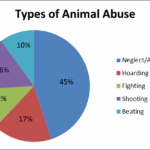When considering the intricacies of animal cruelty laws, one must delve into a myriad of questions that can illuminate the varied dimensions of this pressing issue. Animal cruelty is not merely a legal infraction; it is a societal dilemma that challenges our ethical compass and reflects our values as a civilization. So, what questions should one pose to truly understand and critically evaluate the framework of animal cruelty legislation? Here, we present an extensive exploration of this pivotal subject.
Firstly, one might ponder: what constitutes animal cruelty? The definitions can vary significantly across jurisdictions. The American Bar Association outlines this legal concept broadly to encompass acts of intentional harm, neglect, and exploitation. However, the ambiguity that often arises begs a deeper inquiry: how do varying interpretations of animal cruelty affect enforcement? Laws may stipulate specific acts—such as physical violence or abandonment—but do they adequately cover emotional distress or psychological abuse? These questions challenge the sufficiency of existing statutes and compel a reevaluation of how we perceive and protect animal welfare.
Next, consider the enforcement of these laws: who is responsible for ensuring compliance, and what frameworks exist for reporting incidents of cruelty? In many regions, animal control agencies or local law enforcement are tasked with upholding these regulations. Yet, the effectiveness of such enforcement can be inconsistent. Individuals may wonder: are these entities equipped with the necessary training and resources to address cruelty adequately? The disparity in training among officials can result in varying levels of responsiveness and care, highlighting a need for uniform standards in handling animal welfare cases.
Furthermore, it is crucial to examine the punitive measures associated with animal cruelty. What penalties do offenders face, and do they serve as a sufficient deterrent? In some locations, fines and community service may be levied; others may call for imprisonment. Yet, an intriguing question emerges: do such consequences truly deter future offenses, or do they simply scratch the surface of a much deeper societal issue? This leads us to reflect on the effectiveness of punishment versus rehabilitation. Should the focus not be on reforming behaviors rather than merely penalizing them? This paradigm shift could pave the way for more meaningful change.
As we dig deeper, we encounter the intersection of animal rights and human rights—how do these spheres influence the drafting and implementation of laws? Are legislators prioritizing animal welfare over the interests of industries that profit from animal exploitation? The agricultural, entertainment, and research sectors face scrutiny, and advocates often question whether such industries wield undue influence over legislative decisions. This poses another critical inquiry: how transparent are the lobbying processes that shape animal welfare policies? Examining these political dynamics can shed light on why certain laws remain stagnant despite overwhelming public support for reform.
Moreover, we cannot overlook the role public awareness and education play in combating animal cruelty. What initiatives are in place to inform and mobilize communities against such behavior? Public campaigns, outreach programs, and educational curricula can empower citizens to recognize and report cruelty. The effectiveness of these efforts merits examination: do we sufficiently equip individuals with the knowledge to advocate for animal welfare? If ignorance continues to permeate society, how can we hope to foster a culture of compassion and accountability?
Another pivotal question centers around the available resources for victims of cruelty—both animal and human. What support systems are available to individuals who expose animal abuse? Whistleblowers and activists facing backlash may feel isolated or threatened in advocating for vulnerable beings. Therefore, it is imperative to evaluate the protections afforded to these individuals. Are there safeguards in place to ensure their safety and rights? The courage it takes to speak out against cruelty deserves recognition, and such support could incentivize more witnesses to come forward.
Equally important is the consideration of how animal cruelty laws adapt to societal changes. In what ways are these laws evolving with our shifting understanding of animal sentience and welfare needs? As science progresses and our comprehension of animal behavior and emotions deepens, legal frameworks must also transform accordingly. Are legislators receptive to these advancements, or do outdated perceptions hinder the evolution of animal rights? This question engages with fundamental concepts of ethics and morality, compelling us to reassess our responsibilities toward non-human beings.
Finally, as animal activism gains momentum, one must ask: what role do non-profit organizations and advocacy groups play in shaping and amending animal cruelty laws? These entities often serve as the frontline warriors in the battle against cruelty. They work tirelessly to lobby for change, conduct research, and raise public consciousness. However, we must challenge ourselves to consider the efficacy of their strategies—are they utilizing the most impactful methods to achieve their goals? This exploration of their strategies invites a discussion on collaboration between societies, governments, and non-profits to create comprehensive and effective legal frameworks that not only punish cruelty but also promote humane treatment.
In conclusion, the journey through the labyrinth of animal cruelty laws is riddled with poignant questions that challenge existing paradigms. As societies strive to advocate for animal rights, we must engage in constructive discourse to uncover the layers of complexity intertwined within these laws. Whether it is through understanding definitions, examining enforcement frameworks, scrutinizing penalties, or fostering public awareness, the inquiry into animal cruelty is as crucial as it is ongoing. The potential for transformative change within animal welfare legislation beckons us to ask: are we ready to listen and act on the answers we uncover?




